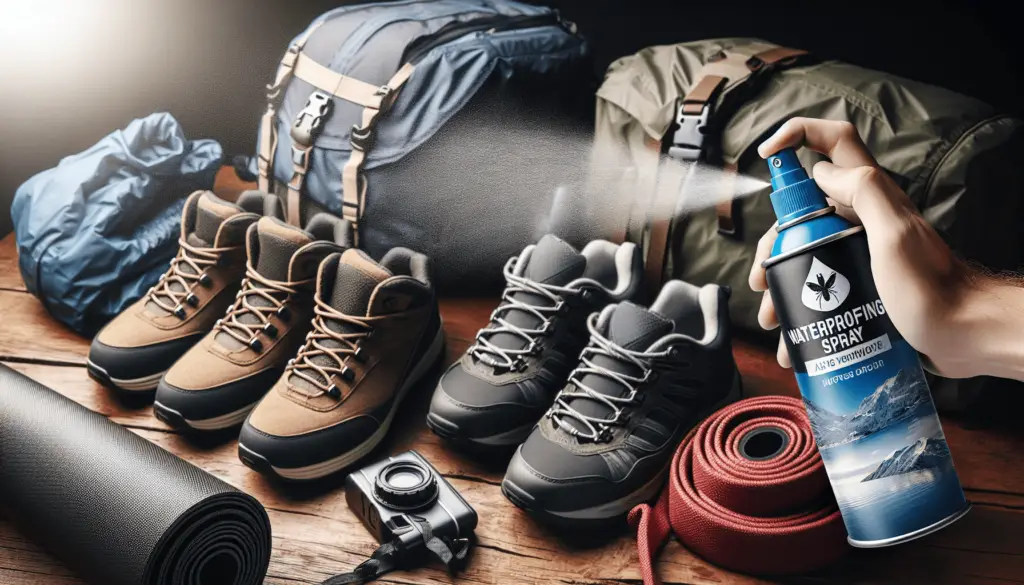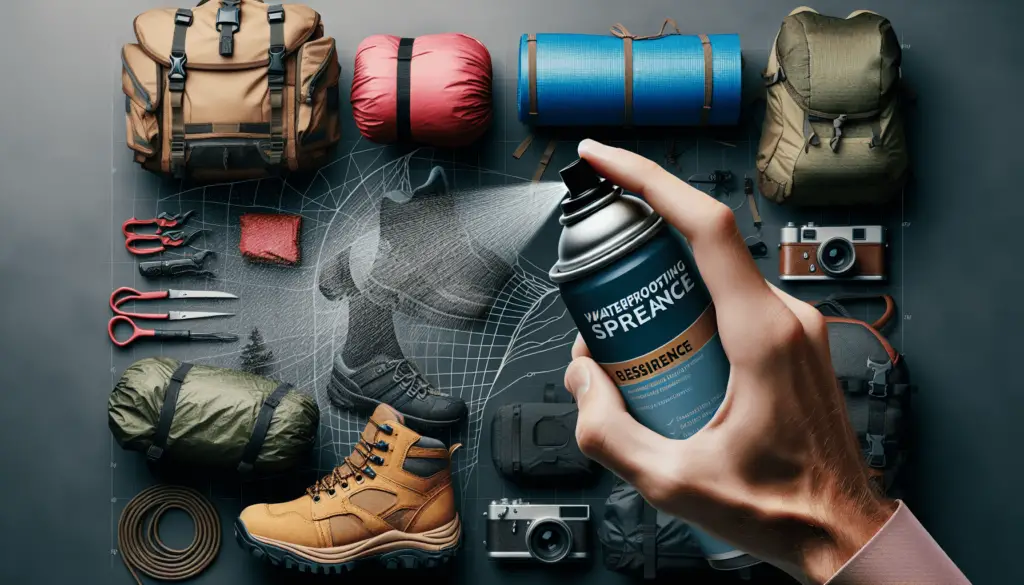Are you tired of your gear getting wet every time you go out on an adventure? Look no further! In this article, we will discuss the best strategies for waterproofing your gear to ensure it stays dry and protected no matter the weather conditions. From using quality waterproofing products to choosing the right storage options, we’ve got you covered. Say goodbye to soggy gear and hello to worry-free exploration with these helpful tips and tricks. Have you ever been caught in the middle of a hike or camping trip when a sudden downpour left all your gear soaking wet? It can be a real challenge to keep your belongings dry while enjoying the great outdoors. But fear not! In this article, we will explore the best strategies for waterproofing your gear, ensuring that you stay dry and comfortable no matter the weather conditions.
Why Waterproofing Your Gear is Important
Keeping your gear dry is crucial for a successful outdoor adventure. Wet gear not only adds extra weight to your pack, but it can also lead to discomfort, hypothermia, and damage to your belongings. By waterproofing your gear, you can enjoy your outdoor activities with peace of mind, knowing that your equipment and essentials are safe from the elements.
The Consequences of Not Waterproofing Your Gear
Picture this: you’re out on a multi-day trek, and a heavy rainfall starts. Your tent, sleeping bag, and clothes get soaked, adding unnecessary weight and discomfort. In extreme cases, not waterproofing your gear could lead to serious health risks, such as hypothermia. It’s essential to take the necessary precautions to protect your gear and yourself from the harsh effects of wet conditions.

Best Strategies for Waterproofing Your Gear
Now that we understand the importance of waterproofing our gear, let’s delve into some of the best strategies to ensure your equipment stays dry and functional throughout your outdoor adventures.
Waterproofing Spray
One of the simplest and most effective ways to waterproof your gear is by using waterproofing sprays. These sprays create a protective layer on fabric surfaces, preventing water from seeping through. Whether you’re waterproofing your tent, backpack, or hiking boots, a waterproofing spray can provide an extra layer of defense against moisture.
How to Use Waterproofing Spray
Using waterproofing spray is a straightforward process. Simply follow these steps:
- Clean the gear you want to waterproof: Make sure the surface is free of dirt, dust, and other contaminants before applying the spray.
- Apply the spray evenly: Follow the manufacturer’s instructions on how to apply the spray. Be sure to cover the entire surface thoroughly.
- Let it dry: Allow the sprayed gear to dry completely before exposing it to water.
- Test for effectiveness: Sprinkle some water on the treated surface to check if the spray is working. If the water beads up and rolls off, your gear is now waterproofed.
Benefits of Waterproofing Spray
Waterproofing spray offers several benefits, including:
- Ease of application: Waterproofing spray is quick and easy to apply, making it a convenient solution for busy outdoor enthusiasts.
- Versatility: Waterproofing spray can be used on various gear, including tents, clothing, backpacks, and even footwear.
- Long-lasting protection: Once applied, waterproofing spray provides durable protection against moisture, ensuring your gear stays dry in wet conditions.
Types of Waterproofing Sprays
There are different types of waterproofing sprays available, each designed for specific materials and applications. Here are some common types of waterproofing sprays:
| Type | Best for |
|---|---|
| Silicone-based | Tents, backpacks |
| Durable water repellent (DWR) | Clothing, footwear |
| Fluoropolymer-based | Outdoor gear |
Choose a waterproofing spray that suits your specific needs and gear to ensure the best results.
Waterproof Bags and Cases
Another effective strategy for waterproofing your gear is to use waterproof bags and cases. These specialized containers are designed to keep your belongings dry and protected, even in the most challenging conditions. Whether you’re kayaking, hiking, or traveling, waterproof bags and cases are essential for safeguarding your valuables from water damage.
How to Use Waterproof Bags and Cases
Using waterproof bags and cases is a simple yet effective way to keep your gear dry. Follow these steps to maximize their protective capabilities:
- Choose the right size: Select a waterproof bag or case that fits your gear or valuables snugly to prevent water from seeping in.
- Seal properly: Ensure that the bag or case is sealed tightly to create a watertight barrier. Double-check the closure mechanism to avoid any leaks.
- Test for leaks: Before heading out, fill the bag or case with paper towels and submerge it in water. Check for any signs of moisture to ensure it is truly waterproof.
Benefits of Waterproof Bags and Cases
Waterproof bags and cases offer numerous advantages, including:
- Submersible protection: Waterproof bags and cases are designed to keep your gear dry even when submerged in water, making them ideal for water-based activities.
- Floatation capability: Some waterproof bags and cases are buoyant, ensuring that your belongings stay afloat in case of accidental drops in water.
- Durability: Made from robust materials, waterproof bags and cases are built to withstand rough handling and harsh environments.
Types of Waterproof Bags and Cases
There are various types of waterproof bags and cases available to suit different needs and preferences. Here are some commonly used options:
| Type | Best for |
|---|---|
| Dry bags | Camping, boating |
| Waterproof backpacks | Hiking, commuting |
| Waterproof phone cases | Water activities, travel |
Select the appropriate waterproof bag or case based on your intended use to ensure optimal protection for your gear.
Seam Sealing
Seam sealing is a crucial step in waterproofing outdoor gear, especially tents, tarps, and rain jackets. Seams are vulnerable points where water can penetrate, compromising the overall waterproofing capabilities of your equipment. By properly sealing these seams, you can prevent water leaks and ensure that your gear remains dry and functional.
How to Seam Seal
Seam sealing may sound daunting, but with the right tools and techniques, you can effectively waterproof your gear. Here’s a step-by-step guide to seam sealing:
- Identify the seams: Locate the seams on your gear, paying attention to areas where two pieces of fabric are stitched together.
- Clean the seams: Thoroughly clean the seams using a damp cloth or brush to remove dirt, debris, and any existing waterproofing residue.
- Apply seam sealer: Use a seam sealer, such as a specialized seam tape or liquid sealant, to cover the seams completely.
- Dry and cure: Allow the seam sealer to dry and cure according to the manufacturer’s instructions before using the gear in wet conditions.
Benefits of Seam Sealing
Seam sealing offers several benefits, including:
- Enhanced waterproofing: Sealed seams prevent water from seeping through the stitching, ensuring that your gear remains dry and leak-free.
- Extended gear lifespan: By protecting the seams from water damage, seam sealing can prolong the life of your outdoor gear, saving you money in the long run.
- Peace of mind: With properly sealed seams, you can enjoy your outdoor adventures without worrying about soggy gear or water leaks.
Types of Seam Sealers
There are different types of seam sealers available for waterproofing gear, each with unique properties and applications. Here are some common types of seam sealers:
| Type | Best for |
|---|---|
| Seam tape (pressure-sensitive) | Tents, rain gear |
| Liquid sealant (urethane-based) | Backpacks, tarps, jackets |
| Seam sealer pens | Small repairs, quick fixes |
Choose a seam sealer that matches the material of your gear and provides long-lasting waterproofing for optimal performance.
Waterproof Clothing
When it comes to staying dry outdoors, waterproof clothing is a must-have for any adventurer. Whether you’re hiking, skiing, or camping, having the right apparel can make a significant difference in your comfort and safety. From rain jackets to rain pants, investing in high-quality waterproof clothing can keep you dry and warm in wet conditions.
How to Choose Waterproof Clothing
Selecting the right waterproof clothing is essential for staying dry and comfortable during your outdoor activities. Consider the following factors when choosing waterproof apparel:
- Waterproof rating: Look for clothing with a high waterproof rating (expressed in millimeters) to ensure effective water protection.
- Breathability: Opt for waterproof clothing that is breathable to prevent moisture buildup from sweat and condensation.
- Durability: Choose durable materials that can withstand rugged outdoor conditions without compromising waterproofing capabilities.
- Fit and comfort: Select waterproof clothing that fits well and provides ample freedom of movement for unhindered performance.
Benefits of Waterproof Clothing
Waterproof clothing offers numerous advantages, such as:
- Protection from the elements: Waterproof clothing shields you from rain, snow, and wind, keeping you dry and warm in challenging conditions.
- Enhanced comfort: Breathable waterproof fabrics allow moisture to escape, preventing overheating and clamminess during physical activities.
- Versatility: Waterproof clothing can be worn for various outdoor pursuits, making it a versatile investment for all-season adventures.
Types of Waterproof Clothing
There are different types of waterproof clothing available to suit your specific needs and preferences. Here are some essential pieces of waterproof apparel:
| Type | Best for |
|---|---|
| Waterproof rain jacket | Hiking, camping, commuting |
| Rain pants | Outdoor work, cycling, fishing |
| Rain poncho | Backpacking, emergency shelter |
Choose waterproof clothing that matches your outdoor activities and provides the necessary protection and comfort for your adventures.

Conclusion
Waterproofing your gear is essential for enjoying outdoor activities without worrying about the impact of wet conditions. By implementing the best strategies for waterproofing your gear, such as using waterproofing sprays, waterproof bags and cases, seam sealing, and waterproof clothing, you can stay dry and comfortable in all weather conditions.
Remember to choose the right waterproofing methods and products based on your gear and activities to ensure optimal protection and performance. With these strategies in place, you can embark on your outdoor adventures with confidence, knowing that your gear is well-equipped to handle whatever Mother Nature throws your way. Happy exploring!
